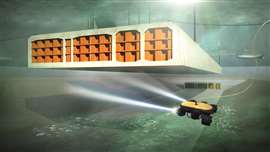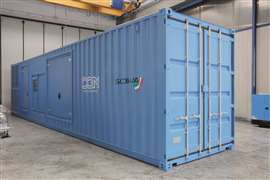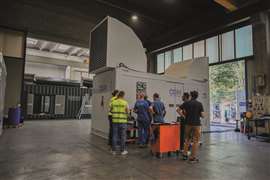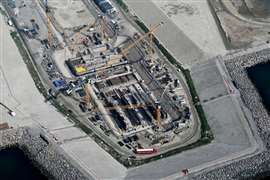CGM gen-sets power Fehmarnbelt tunnel project
17 November 2023
Company supplies 7.3-MVA continuous power to one of Europe’s largest construction projects
 Graphic showing tunnel elements being positioned in Fehmarnbelt tunnel. (Photo: CGM)
Graphic showing tunnel elements being positioned in Fehmarnbelt tunnel. (Photo: CGM)
Generator set manufacturer CGM, which has its headquarters in Vicenza, Italy, is providing power for the construction site of the Fehmarnbelt tunnel. Comprising road and rail links running 18 km between Denmark and Germany, the project is set to deliver the world’s longest immersed tunnel.
According to the Fehmarnbelt project’s website, upon completion in mid-2029, the journey between Rødbyhavn, Denmark, and Puttgarden, Germany, will take seven minutes by train and 10 minutes by car. Road users and train passengers will save about one hour each way over the existing ferry crossing. The Fehmarnbelt link will remain open 24 hours a day, unaffected by ferry schedules and weather. The link will also help to reduce CO2 emissions by allowing traffic to use the shortest and fastest route, while opening capacity on roads and railways.
 CGM 1500P gen-set container. (Photo: CGM)
CGM 1500P gen-set container. (Photo: CGM)
Gen-set details
CGM’s Managing Director Stefano Chilese explained that his company has supplied 20 gen-sets for the spreader pontoons used to precisely distribute sediment for land reclamation, and for the protection layer pontoon, which is used to install sheet metal on the seabed.
“The 20 gen-sets feature 100-kVA FPT Industrial engines certified for EU Stage 5 emissions regulations; Mecc Alte alternators with special coatings; 12 IG1000 and Intelivision 5.2 controllers by ComAp; ABB’s electrical cabinets; and 18-in. touch control panels,” said Chilese. Housed in four 40-ft. High Cube containers, the units deliver a total of 2 MVA (1.6 MW).
 Factory acceptance testing of CGM gen-set for Fehmarnbelt project. (Photo: CGM)
Factory acceptance testing of CGM gen-set for Fehmarnbelt project. (Photo: CGM)
CGM is also supplying eight gen-sets housed in two 20-ft. DNV-certified containers for the two immersion layer pontoons used to position the tunnel sections underwater.
“These eight gen-sets deliver 660 kVA each, in parallel. That is a total of 2,640-kVA prime power per submerged pontoon and 5.3 MVA - in total (4.2 MW),” Chilese said. “These units are powered with Volvo engines certified for IMO Tier 3, using Stamford alternators with special coatings and type IG1000 controllers by ComAp.”
In total, CGM gen-sets will supply 7.3-MVA (5.8 MW) continuous power to this massive construction project.
Tunnel construction
The Fehmarnbelt construction project is led by Femern A/S, a state-owned Danish company, which will also be in charge of operating the tunnel upon completion. Projected costs are expected to total DKK 55.1 billion (about €7.4 billion), which is co-funded by the European Union.
Tunnel entrances are located near Rødbyhavn and Puttgarden. They will be connected via new and upgraded road and rail links. For example, the Danish railway from Ringsted to Rødbyhavn will undergo a substantial upgrade, including two new electrified tracks which will have a top speed of 200 km/h.
The immersed tunnel itself will be formed using 79 standard elements and 10 special elements. These will be produced onsite at a casting factory spread across six production halls. The facility will produce a standard element approximately every two weeks for about three and a half years. Total production time for each element will take nine weeks. The casting process takes place in climate-controlled halls to ensure uniformity and quality, a requirement to achieve the 120-year operational lifetime of the tunnel.
Each standard element is 217 meters long and weighs 73,500 tonnes. They incorporate five openings, with two tubes for the motorway, two for the railway and one service passage. Each special element will include a “basement” area to house related technology; this will facilitate the construction process and tunnel maintenance when in operation.
When an element is ready for deployment, it has waterproof bulkheads fitted at both ends before being towed into place using tugs. The elements are then lowered with millimeter precision into a 12-meter deep trench dredged into the seabed before they are coupled together.
The sealed space between the bulkheads is designed so the external water pressure pushes them together when water is pumped out. This creates a partial vacuum and ensures a watertight connection.
When all elements are assembled, technical and mechanical installations can start. These include railway tracks, ventilation systems, cameras, communication systems, signage and painting.
The final phase will see the tunnel covered with a protective layer of stone, although it is expected that sea currents will eventually cover the tunnel with sand.
STAY CONNECTED



Receive the information you need when you need it through our world-leading magazines, newsletters and daily briefings.
CONNECT WITH THE TEAM








